Intel recently released a pair of rather odd high-end processors: the 14-core Core i9 9990XE and the 28-core Xeon W-3175X. Both have higher clock speeds than other models with similar core count, run much hotter, and have other peculiarities. Because of that, neither of these processors will have a home in our product line at this time – but they are still interesting to test for insight into what current CPU designs are capable of when pushed beyond what is practical.










